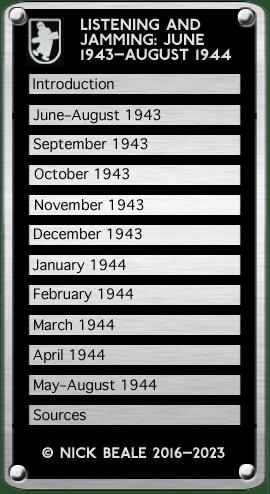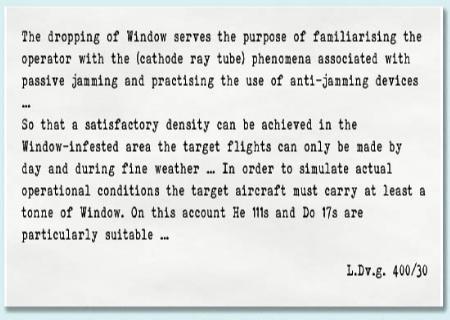|
Early in March the Kriegsmarine’s signals division held a conference on the radar war at sea and at least two of the papers presented discussed how Allied systems might be countered, passively or actively. Kapitänleutnant von Schultz provided the exposition that began this article; the former commander of U-106, Kptltn. Hermann Rasch (now head of Section IVD of the Naval Signals Service), offered an overview of the »Stördienst« (Jamming Service) covering land- and sea-based systems as well as airborne ones Rasch makes it clear that only one airborne jammer was then available, »Kettenhund«, that it was effective only in the 1.20–1.80 cm waveband (the British ASV Mk. II radar operated on 1.70 m) and was not being used on operations because the transmitter could act as a beacon to hostile aeroplanes and could interfere with the search and detection capabilities of the machine carrying it. There was currently no centimetre-wavelength jammer (to counter, for example, ASV Mk. III on 10 cm) while the set under development, »Roderich«, was clearly disappointing.
Between them, Schultz and Rasch offer perhaps the best available picture of what Horch- und Störstaffel 2’s activities actually were, as well as clues to what it had not been doing. Intermittent sorties by one or two aircraft could never have interfered significantly with Allied radars over an area so large as the Bay of Biscay (c. 550 km North–South and 650 km East–West) although it is of course possible that individual jamming trials were carried out. Any local jamming support for, say, a returning U-boat would have been compromised by the “beacon effect” mentioned above; a lone aircraft could however be very valuable listening-in on Allied radars and communications during anti-submarine operations. Monitoring electronic emanations was a well-established form of intelligence although in this case it seems that little of significance had been learned despite many months of operations. The intention on 1 March was that 9U+CB should start from Mérignac at 2215 and return from 0600–0700. Apart from the marginally earlier landing time this mission profile duplicated the previous night’s, right down to the route (Mérignac – 24 West 3951–15 West 9053 – Mérignac) which may be a further indication that the original flight had not in fact taken place. At 2230 on the 3rd, the Luftwaffe issued “data for operation of Horch- und Störstaffel 2”: He 111 9U+CB had started 20 minutes earlier and was due to return between 0610 and 0710 but nothing was heard by the Y-Service. Again two destroyers, Z 23 and ZH 1 were notified and the aircraft was to transmit “858” if “ship targets” were located. Notice was given on 9 March that an He 111 would be in the air for “target practice” in the vicinity of St. Nazaire from 0900–1100 and again from 1300–1500; on the morning flight it was to drop »Folien« (“foils” = Window) from 0930, suggesting an exercise for radar crews. In 1943 there had been frequent target-towing flights aver the French Atlantic ports, usually by types such as the Fw 44 and Ju W. 34 but these would not suffice for the task at hand:
Although passive jamming was involved, it is far from certain that this was a Horch- und Störstaffel operation since “target representation” was a role normally undertaken by those elements of Fliegerzielgeschwader 2 based in France. On 20 March the Y-Service picked up traffic from a “new” He 111, 9U+AB, as it was returning to base early in the morning; it had taken off at around 2220 the previous night. Single Heinkels were due to fly on the nights of the 21st and 23rd, concluding known operations for the month. Five days later, the Naval Staff was discussing information obtained from Allied prisoners on homing torpedoes and radar performance against different sea targets. In addition: The radar set can be jammed, since autumn 1943 however we have obviously made no use of this possibility. A raid on Mérignac by 123 of the 8th Air Force’s B-17s on 27 March cost the Staffel two aircraft destroyed and one damaged. continued on next page …
|
||||


